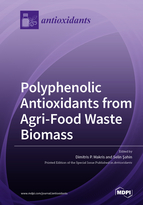Polyphenolic Antioxidants from Agri-Food Waste Biomass
A special issue of Antioxidants (ISSN 2076-3921). This special issue belongs to the section "Natural and Synthetic Antioxidants".
Deadline for manuscript submissions: closed (31 October 2019) | Viewed by 51583
Special Issue Editors
Interests: antioxidants; biorefinery; food waste valorization; green processes; polyphenols
Special Issues, Collections and Topics in MDPI journals
Interests: natural product research; natural food additives; novel separation methods; recovery of natural products; food safety; optimization and statistics
Special Issues, Collections and Topics in MDPI journals
Special Issue Information
Dear Colleagues,
It is my privilege to announce a new Special Issue entitled “Polyphenolic Antioxidants from Agri-Food Waste Biomass”.
Nowadays, the re-use of industrial food residues is of paramount importance in the general framework of rational waste handling and recycling, which aims at the minimizing environmental impact of food production and producing functional food ingredients. Agri-food processing waste has long been considered a valuable biomass, bearing a significant polyphenol load and profile. Polyphenols, aside from being powerful antioxidants that confer inherent stability to a variety of foods, may also possess versatile bioactivities, including anti-inflammatory and chemopreventive properties.
The valorization of agri-food waste as a prominent sources of polyphenols stems from the enormous amount of food-related material discharged worldwide and the emerging eco-friendly technologies that allow high recovery, recycling, and sustainability of these materials.
This Special Issue addresses the concept of recovering natural polyphenolic antioxidants from waste biomass generated by agri-food and related industrial processes. Contributions pertaining to the sustainable production of isolated bioactive compounds or whole extracts and their utilization in the food, cosmetic and pharmaceutical industries are particularly welcome.
Dr. Dimitris P. Makris
Dr. Selin Şahin
Guest Editors
Manuscript Submission Information
Manuscripts should be submitted online at www.mdpi.com by registering and logging in to this website. Once you are registered, click here to go to the submission form. Manuscripts can be submitted until the deadline. All submissions that pass pre-check are peer-reviewed. Accepted papers will be published continuously in the journal (as soon as accepted) and will be listed together on the special issue website. Research articles, review articles as well as short communications are invited. For planned papers, a title and short abstract (about 100 words) can be sent to the Editorial Office for announcement on this website.
Submitted manuscripts should not have been published previously, nor be under consideration for publication elsewhere (except conference proceedings papers). All manuscripts are thoroughly refereed through a single-blind peer-review process. A guide for authors and other relevant information for submission of manuscripts is available on the Instructions for Authors page. Antioxidants is an international peer-reviewed open access monthly journal published by MDPI.
Please visit the Instructions for Authors page before submitting a manuscript. The Article Processing Charge (APC) for publication in this open access journal is 2900 CHF (Swiss Francs). Submitted papers should be well formatted and use good English. Authors may use MDPI's English editing service prior to publication or during author revisions.
Keywords
- agri-food wastes
- antioxidants
- biomass
- polyphenols
Related Special Issues
- Extraction of Antioxidants from Food Waste II in Antioxidants (14 articles)
- Extraction of Antioxidants from Food Waste in Antioxidants (8 articles)








